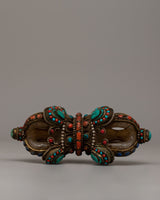
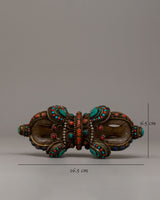
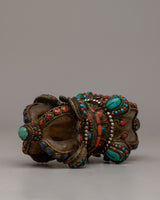
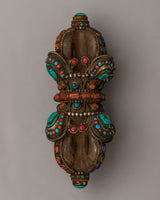
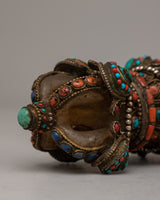

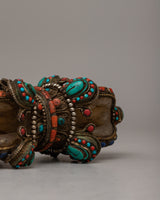
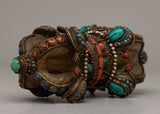
Vajra Dorje Crystal | A Sacred Symbol of Strength and Clarity

100% AUTHENTIC

HANDMADE

FREE SHIPPING
Vajra Dorje Crystal
About Our Tibetan Vajra :
Presenting the Vajra Dorje Crystal, a magnificent work of spiritual art that is carefully handmade from crystal stone. A stunning variety of natural stones, including coral, lapis lazuli, ruby, and turquoise, are skillfully inlaid into this one-of-a-kind relic to accentuate both its spiritual and aesthetic significance. The vivid coral denotes safety, the deep blue lapis lazuli promotes intelligence, the brilliant ruby energizes, and the calming turquoise stands for tranquility and healing.
In Buddhist ceremonies, this Vajra Dorje is an effective implement that represents the qualities of a thunderbolt (irresistible force) and a diamond (indestructibility). This artwork is incredibly beautiful and has profound symbolic meaning due to the mix of the inlaid stones' rich hues and sparkling purity. It is the perfect spiritual tool for ceremonial and meditation use, assisting practitioners in focusing their intentions and energies in a visually striking way.
Introduction to Vajra :
Vajra is a Sanskrit word meaning both thunderbolt and diamond. It is a weapon used as a ritual object to symbolize the properties of a diamond (indestructibility) and a thunderbolt (irresistible force). The five-pronged vajra is the most commonly seen vajra.
This Vajra is to be used during empowerment. Usually needs two Vajras, one for the Mandala tied to the Sung-Tak with five coloured cords and the second for the Vajra Master. Sanskrit word vajra or Dorje in Tibetan is defined as "diamond" or "adamantine." As such, the word vajra sometimes signifies enlightenment, or the absolute reality of shunyata, emptiness. Dorje offers protection and invokes blessings.
--------------------------------------------
Size: 6.5 cm(Height) x 16.5 cm(width)
Weight: 0.54 kg
--------------------------------------------
How to set up your own Buddhist Shrine?
-Find a clean, quiet, and uncluttered spot.
-Set up an altar table, and cover it with an altar cloth that calls to you.
-Place your sacred item (statue, thangka, or a picture of Buddha) at the centre.


















